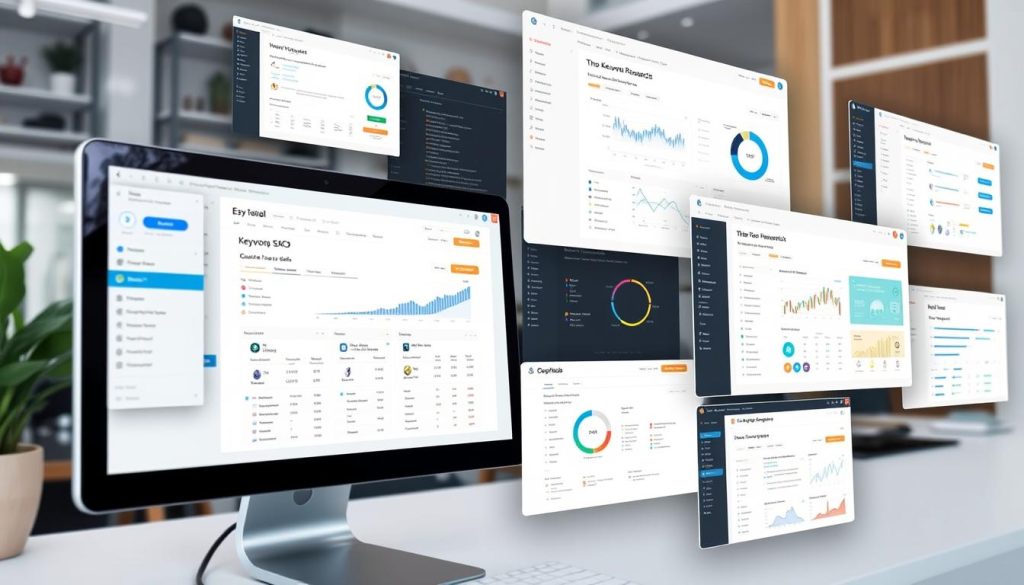
Freelancers who want to stop chasing low-value gigs need one thing more than anything: visibility where clients are actively searching. Your portfolio and testimonials matter, but they only work if the right people can find your site. That’s why SEO for freelancers is a practical, repeatable way to turn cold outreach into steady inbound inquiries from higher-paying clients.
Whether you’re a designer, writer, developer, or consultant, using targeted search engine optimization and smart keyword choices can shift your business from feast-or-famine to a predictable pipeline. This guide covers the benefits of SEO, how to do keyword research, on-page and local optimizations, the tools to use, and a simple implementation plan so you can start seeing results without spending all your time on promotion.
Start with a quick SEO checklist — a small, practical step you can take today that takes less than a day to complete.
3 Core Ways SEO Benefits Freelancers
Before we jump into tactics, here’s a concise view of why SEO for freelancers is a more reliable way to find clients than many other channels:
1. Increased Targeted Visibility
Search engines put your work in front of people who are actively looking for what you offer — not just scrolling past endless social feeds. When someone searches for “UX design freelancer for fintech” they usually have a specific project in mind and are closer to hiring than someone seeing a social post.
That means fewer cold leads and more conversations with the right clients at the right moment.
2. Authority Building
High rankings in search results act like social proof: people trust sites that appear near the top. Industry studies consistently show most clicks concentrate on the first page of search results, so being visible there makes your services look credible before prospects even open your site.
Over time, ranking for niche search terms builds recognition and makes it easier to command higher rates from clients who perceive you as an expert.
3. Long-Term Client Pipeline
SEO is an investment that keeps working. Unlike paid ads that stop producing the moment you cut the budget, well-optimized content continues to attract visitors and generate leads 24/7.
That steady flow of inbound inquiries helps you spend less time on outreach and more time doing the work you prefer — and lets you be selective about which clients you take on.
Did you know? Freelancers who adopt basic SEO practices often report spending substantially less time on outreach while maintaining or increasing income — a practical outcome many find is a great way to reclaim time for higher-value work. (If you want sources for these trends, add a note and we’ll include citations.)
Actionable SEO Strategy #1: Keyword Research for Freelancers
Effective SEO for freelancers begins with knowing exactly what your ideal clients type into search engines. Targeted keyword research tailored to your niche helps you attract people ready to hire, not just casual browsers.
How to Find Your Profitable Freelance Keywords
For freelancers, focus on three high-impact keyword types that signal hiring intent or solve client problems:
- Service + Freelancer Keywords: Combine your service with “freelancer” or “for hire” (e.g., “B2B copywriting freelancer,” “React developer freelancer”). These show clear hiring intent and are often lower-competition than broad service terms.
- Location-Based Keywords: If you target local clients or want to highlight your city, add geographic qualifiers (e.g., “UX design freelancer NYC,” “freelance photographer London”). Local terms can be a great way to beat larger national competitors.
- Problem-Solution Keywords: Target phrases people use when searching for answers you provide (e.g., “how to create website content that converts,” “fix WordPress performance issues”). These are ideal for content that attracts clients earlier in the decision process.
Step-by-step: a quick, low-cost way to start
If you don’t have paid tools, try this 10–30 minute workflow:
- Pick 3 seed terms (one service, one location-based, one problem phrase).
- Plug them into Google’s autocomplete and “People also ask” to collect related queries.
- Check those queries in Google Search Console (if you have it) or a free tool like AnswerThePublic for volume ideas.
- Prioritize long-tail phrases with clear hiring intent and low competition for faster wins.
Keyword Research Example (illustrative)
Below is an example output for a freelance content writer specializing in SaaS. These numbers are illustrative—use your tool of choice (Search Console, Ubersuggest, Ahrefs) and note the date when you pull data.
| Keyword | Monthly Search Volume | Competition | Intent |
| SaaS content writer | 590 | Medium | Hiring |
| B2B SaaS copywriter | 320 | Low | Hiring |
| SaaS blog writer for hire | 210 | Low | Hiring |
| How to write SaaS case studies | 170 | Low | Information |
Ready to find your profitable keywords?
If you have a little budget, a SEMrush trial will speed this up. If not, try a three-term manual check in Google Search Console or use AnswerThePublic for question-based ideas.
Actionable SEO Strategy #2: On-Page SEO for Freelance Websites
After you pick target keywords, optimize your freelance website so those terms help real clients find and hire you. On-page SEO for freelancers balances search engine requirements with clear, client-focused messaging that converts visitors into inquiries.
Essential On-Page SEO Elements for Freelancers
1. Service Page Optimization
Give every service its own page targeted to a specific keyword. This helps search engines and people understand exactly what you offer.
Before/after example (compact):
URL (example): /services/b2b-saas-content-writer
Title Tag (before → after): B2B Content Writer → B2B SaaS Content Writer | Conversion-Focused Copy
Meta Description (before → after): Freelance writer available → Experienced B2B SaaS content writer helping software companies increase conversions with SEO-optimized content. View portfolio & rates.
H1 Heading: B2B SaaS Content Writing Services
Micro-steps for each service page:
- Pick one primary keyword and 2–3 related secondary keywords.
- Write a clear H1 that matches the primary keyword.
- Front-load the primary keyword in the title tag and the first paragraph.
- Add a short benefits section that explains client outcomes (time saved, revenue, conversions).
- Include a CTA (contact form, calendar link) that’s visible above the fold.
2. Portfolio Optimization
Your portfolio is working content — treat each project as a landing page optimized for a specific keyword and client type.
- Use descriptive, keyword-rich project titles (e.g., “E-commerce Product Description Copy for Fashion Brand”).
- Write concise case studies that include the challenge, your approach, and measurable results.
- Add alt text and descriptive filenames to every image (e.g., “saas-landing-page-copy-example.jpg”).
- Include short testimonials that reference the industry or outcomes (e.g., “helped increase MQLs by 35%”).
3. Content Structure Best Practices
- Use a logical heading hierarchy (H1 for the page, H2 for main sections, H3 for subsections) so search engines and people can scan your web page quickly.
- Front-load keywords naturally in titles, headings, and the first 100 words.
- Keep paragraphs short (2–3 sentences) to improve readability on desktop and mobile.
- Include internal links to related services, case studies, and contact pages to guide visitors deeper into your site.
- Optimize images with descriptive filenames and alt text to capture image search traffic and improve accessibility.
“After optimizing my service pages with targeted keywords, I saw a 43% increase in qualified leads within three months. The clients coming through search were already familiar with my work and ready to discuss projects.”
At-a-glance checklist: one primary keyword per page, optimized title and meta, clear H1, 1–2 internal links, optimized images, and a visible CTA. If you want, download a printable on-page audit template to run through these items in under 30 minutes.
Real-World Success: Freelance Writer SEO Case Study
Here’s a practical example of how focused SEO work helped one freelancer move from scrambling for low-paid gigs to booking higher-value work consistently.
Case Study: From Struggling to Selective
Freelancer: Michael P., B2B SaaS Content Writer
The Challenge
Michael relied heavily on marketplaces and referrals, which pushed him into competing on price. He spent a lot of time pitching and juggling short-term jobs, leaving little room to increase rates or build deeper client relationships.
The SEO Strategy
Michael applied a repeatable freelance SEO approach (examples below are representative and illustrative; numbers were tracked via Google Analytics and Search Console):
- Targeted the keyword “B2B SaaS content writer” and related long-tail phrases to capture hiring intent.
- Built dedicated, optimized service pages (case studies, white papers, blog writing) with clear H1s and meta tags for each service.
- Published eight long-form, helpful articles that addressed common SaaS content problems and linked to his service pages.
- Turned portfolio entries into SEO-friendly case studies that listed measurable outcomes.
- Secured backlinks through targeted guest posts on marketing blogs to increase domain relevance.
The Results (After 6 Months)
- Improved rankings: reached top 3 for primary search terms and #1 for a niche term (“SaaS case study writer”).
- Traffic grew from roughly 50 to ~780 monthly visitors (tracked in Google Analytics).
- Consistent lead flow: 15–20 qualified inquiries per month, allowing selective client intake.
- Rate growth: raised project fees by ~200% while remaining fully booked.
- Reduced dependency on freelance platforms and cold outreach.
Key takeaways you can replicate
- Pick one hire-intent keyword and build a service page around it — make the value for clients explicit (time saved, conversions, revenue).
- Publish one detailed, problem-solving article per month and internally link it to the relevant service page.
- Convert portfolio items into case studies with measurable results and include those as landing pages for targeted keywords.
- Track progress with Google Analytics and Google Search Console so you can measure traffic, impressions, and which keywords drive leads.
If you’d like, download a simple case-study template to record your own before/after metrics and replicate Michael’s playbook step by step.
Actionable SEO Strategy #3: Local SEO for Location-Based Freelancers
If you work with local clients or want to highlight your city as a selling point, local SEO for freelancers is a high-impact, low-cost strategy. Many clients still prefer working with nearby professionals, and local search often signals strong hiring intent.
Local SEO Checklist for Freelancers
- Create and prioritize your Google Business Profile (formerly Google My Business). Set up a service area business listing if you work from home so you get local visibility without exposing your address.
- Optimize title tags and meta descriptions with location qualifiers — e.g., Title: “Freelance Web Designer in Boston | UX & Conversion” and Meta: “Boston-based freelance web designer helping startups improve conversion and user experience.”
- Publish dedicated location pages or sections if you serve multiple cities (each page should include local keywords, testimonials from local clients, and a map or service area description).
- Ask satisfied local clients for reviews on Google and industry-specific platforms — include a short review request template: “Hi [Name], would you mind leaving a 2–3 sentence Google review about the project we completed? It helps local clients find my services.”
- List your services in trusted local directories and industry platforms relevant to your niche to increase citations and search engine confidence.
- Create location-specific content (e.g., “Web Design Trends in Boston Startups”) to capture search queries from local businesses and demonstrate niche expertise.
Important: Local rules vary — make sure to check Google’s current guidelines for service area business listings and privacy rules in your region before displaying any home address. When in doubt, use a business address or virtual office to protect your privacy.
Quick 3-step local audit (10 minutes): 1) Search your main service + city in Google and note who appears in the local pack; 2) Verify your Google Business Profile is complete and has current contact info; 3) Check for at least one recent local review — if none, email two recent clients your review request template.
5 Essential SEO Tools for Freelancers (Free & Affordable)
You don’t need an enterprise budget to implement effective SEO for freelancers. These tools give you the core functionality to do keyword research, technical checks, and on-page optimization at freelancer-friendly prices. (Pricing and limits change — check each vendor for the latest plans.)

1. Ubersuggest
Best for: Quick keyword research and content ideas — bloggers and solo consultants
Free plan: Limited daily searches
Paid plan: Affordable monthly or annual options
Ubersuggest offers keyword suggestions, estimated search volume, and basic competitive insights. It’s a practical way to find low-competition keywords and topic ideas without a big investment.
2. AnswerThePublic
Best for: Finding question-based keywords — great for FAQ and content pages
Free plan: Limited searches
Paid plan: More queries and export options
Use AnswerThePublic to discover the questions people ask about your services. These question keywords are ideal for creating content that answers client problems and captures search intent.
3. Google Search Console
Best for: Tracking performance in Google and spotting technical issues — essential for all freelancers
Cost: Free
Google Search Console shows which keywords and pages bring impressions and clicks from Google search, and it flags technical problems that affect rankings. Run a quick performance check to see which pages are already getting attention.
4. Yoast SEO (WordPress Plugin)
Best for: On-page SEO optimization — WordPress freelancers and agencies
Free plan: Basic features
Paid plan: Advanced features and integrations
Yoast gives real-time feedback on titles, meta descriptions, headings, and readability. It’s a practical way to implement search engine optimization on your WordPress website without deep technical knowledge.
5. Ahrefs Webmaster Tools
Best for: Site audits and backlink checks — developers and freelancers tracking technical SEO
Cost: Free (with account)
Ahrefs Webmaster Tools provides site audits to find technical SEO issues and basic backlink data to understand who links to your site. It’s useful for diagnosing problems that might block search engines from indexing your pages.
Alternative free stack for absolute beginners: Google Keyword Planner (via Google Ads account) + Google Search Console + a free site crawler (Screaming Frog free tier) — this combo covers keyword discovery, performance tracking, and basic technical checks without subscription costs.
Quick example: to run a basic audit in under 20 minutes, open Google Search Console > Performance to see top queries (search), then run an Ahrefs or Screaming Frog crawl to catch broken pages and missing meta tags. These two steps identify the highest-impact fixes for your website.
Implementing Your Freelance SEO Strategy: Next Steps

Now that you know why SEO for freelancers works, use this practical 30-day plan to turn strategy into action. I’ve added time estimates and micro-tasks so you can complete each step without it taking over your workweek.
- Days 1-3: Conduct keyword research (2–4 hours) – Identify 5–10 primary and secondary keywords. Micro-tasks: pick 3 seed terms, use Google autocomplete and AnswerThePublic for ideas, and log results in a simple spreadsheet.
- Days 4-7: Audit your existing website (3–5 hours) – Run Google Search Console and a quick site crawl (Screaming Frog free tier or Ahrefs WMT). Micro-tasks: list broken pages, missing meta descriptions, and slow-loading images to fix.
- Days 8-14: Optimize your service pages (4–6 hours) – Update titles, H1s, meta descriptions, first paragraphs, and images to target your keywords. Micro-tasks: apply one primary keyword per page, add 1–2 internal links, insert a clear CTA above the fold.
- Days 15-21: Create or update your portfolio (3–6 hours) – Turn projects into keyword-optimized case studies. Micro-tasks: write a short challenge → approach → results section, add alt text to images, and request one testimonial per case study.
- Days 22-25: Set up Google Business Profile (1–2 hours) (if targeting local clients) – Claim and complete your profile, add service categories, photos, and a short description with location keywords. Micro-tasks: verify service area settings if you work from home and ask two recent clients for reviews using a short template.
- Days 26-30: Create one piece of valuable content (4–8 hours) – Publish a long-form article or guide that answers a common client problem and links to your service pages. Micro-tasks: outline the article around a problem-solution keyword, include examples, and add 2–3 internal links.
“The best time to start SEO was when you first launched your freelance business. The second best time is today. Small, consistent work compounds — even an hour or two per week adds up.”
Pro Tip: Set aside 2–3 hours each week for ongoing SEO tasks: publish one short post or update, fix technical items flagged in Search Console, and outreach for one backlink. These regular, focused sessions are the most practical way to improve search engine visibility without losing billable work time.
If you want a ready-to-use version, download the printable 30-day checklist (day-by-day micro-tasks) or click the button below to start your first-week plan.
Transform Your Freelance Business with SEO
Implementing SEO for freelancers is more than ticking technical boxes — it’s a strategic way to position your services so the right clients find you when they search. In a competitive freelance market, stronger search visibility helps you stand out from other businesses and win clients who value experience over price.
Unlike paid ads that stop delivering when you stop paying, good search engine work compounds. Proper search engine optimization builds a sustainable source of inbound leads that can deliver results for months or years, making it a cost-effective investment for your business.
Whether you’re just starting to become freelance or you already run a steady operation, the steps in this guide show a practical way to improve your websites and content so they attract higher-quality clients who are willing to pay for expertise.
Ready to transform your freelance business?
Start with a free SEO audit to identify your biggest opportunities, or download a quick 5-point on-page checklist if you prefer a non-branded option.
“I followed the 30-day plan and within four months I was booking fewer clients but earning more — search brought better-fit projects.” — A. Lopez, freelance web designer
Frequently Asked Questions About SEO for Freelancers
How long does it take to see results from SEO as a freelancer?
TL;DR: Expect early signs in a few months, meaningful gains in 6–12 months depending on effort and competition.
Most freelancers begin seeing initial results within 3–6 months, with more significant improvements typically occurring between 6–12 months. Timelines vary widely based on niche competitiveness, content quality, and technical setup. To speed things up, focus on less competitive, long-tail keywords that match clear hiring intent and make sure each new piece of content targets a specific client problem.
Do I need technical skills to implement SEO on my freelance website?
TL;DR: No — basic SEO is doable without coding; plugins and simple tools cover most needs.
Basic SEO implementation requires minimal technical skills, especially if you use a content management system like WordPress with plugins such as Yoast. Start with content optimization, keyword research, and improving meta tags and images. For technical SEO issues (site speed, structured data, crawl errors), you can learn the essentials or hire affordable help for specific tasks.
Is SEO worth the effort for freelancers who already have a steady client base?
TL;DR: Yes — SEO builds a sustainable pipeline, reduces platform dependence, and enhances authority.
Even with steady clients, SEO offers three clear benefits: (1) It creates a pipeline of higher-quality leads so you can be selective and increase rates; (2) It reduces dependency on referral sources or commission-taking platforms; and (3) It builds your authority in search engines and among people who discover you via search results. Think of it as a long-term investment that complements your existing client work.
How should I measure SEO ROI as a freelancer?
TL;DR: Track leads and revenue from organic search, not just traffic.
Use Google Analytics and Google Search Console to track organic traffic, impressions, and top queries. More importantly, track the number of qualified leads and revenue that originate from organic search (use UTM tags or contact form fields to capture source). Calculate ROI by comparing new monthly revenue from organic leads to the time or cost invested in SEO.
When should I consider hiring outside help for SEO?
TL;DR: Hire when technical issues or scaling content/links take more time than you can afford.
If technical SEO (site migrations, speed optimization, complex schema) or ongoing content and link-building take more hours than you can reasonably allocate, hire a specialist or agency. A good rule: if SEO work consistently eats into billable hours and you’re not seeing proportional results, outsourcing specific tasks is often the most cost-effective route.



